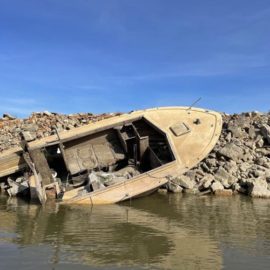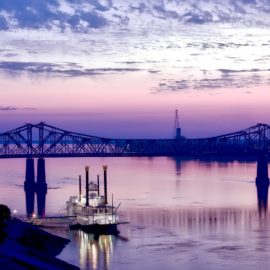
Water flows down the Mississippi bring many things – including trash. Knowing where it comes from helps stop it at the source. How? By floating specially constructed bottles with GPS in them. This test, now in progress, was started first in Baton Rouge.
Scientists are placing GPS devices inside plastic bottles to study how trash enters the watershed and travels downstream, with the ultimate goal being to reduce pollution in rivers and oceans. The initiative was launched Saturday in Baton Rouge, the first of three cities participating in a pilot program that involves tracking several bottles on their journeys toward the Gulf of Mexico. East Baton Rouge Parish Mayor Sharon Weston Broome held a news conference Saturday morning on a floating barge at Shamrock Marine. With the river flowing swiftly behind her, Broome said Baton Rouge is proud to be the first pilot site. She serves as co-chair of the Mississippi River Cities and Towns Initiative, which is organizing the program. “I’m sure you recognize the value of this monumental waterway,” she said. “It physically shapes our community, it is a staple of our economy and it is an asset to our environment in Louisiana.”
the advocate
The Mississippi drains 40% of the country and this research project will use ten bottles coming from St. Paul, Minnesota and St. Louis, Missouri. Baton Rouge will have three of the bottles.
Jenna Jambeck, a distinguished professor in environmental engineering at the University of Georgia, said the GPS technology contained in these bottles has never before been used in the United States, though she was involved in similar research on the Ganges River, which flows through India and Bangladesh. She said one of the bottles released into the Ganges traveled more than 1,200 miles. Researchers planned to release the Baton Rouge bottles on Saturday, but delayed their deployment because of minor technical difficulties. Jambeck said that, if the bottles get stuck somewhere downstream, researchers plan to rescue and redeploy them. She said the information they provide will help fill a “data gap” in estimating the overall quantity of plastic in rivers and oceans. he data will also be made available to the public online at debristracker.org, where people can download an app and contribute to an online database of plastic pollution. A group of LSU students is using the app to document plastic trash recovered from local waterways.
Large amounts of trash end up in the Gulf and then into the Atlantic from the Mississippi. Recently an endangered whale was killed by a piece of plastic that tore up her stomach.
A recent study found that a small piece of plastic was enough to kill a 38-foot whale that washed up near the Florida Everglades in 2019. Scientists found the plastic had sliced through its insides, causing internal bleeding and ultimately a painful death. The species, known as a Rice’s whale, was just recently discovered and is believed to live only in the Gulf of Mexico, where pollution is proving an increased threat to these endangered animals. In 2016, the United States generated more plastic waste than any other country in the world, according to research from Jambeck and others. “You don’t have to look too far around our city to see that we have a trash problem,” said Mark Benfield, with the LSU Department of Oceanography and Coastal Sciences. He said the scope of the problem can seem overwhelming, especially because it encompasses millions of people living in the Mississippi River drainage basin.
We do create too much trash, far too much.



